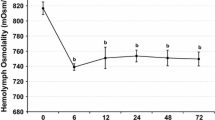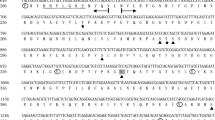Abstract
Several shrimps can survive in a wide range of salinity by changing the concentration of free amino acids to regulate osmotic pressure. In particular, glutamine and alanine increase and decrease significantly depending on environmental salinity. However, there is little information about the enzymes involved in the metabolism of these amino acids. In this study, we focused on glutamine synthetase (GS), which catalyzes the biosynthesis of glutamine in the kuruma shrimp Marsupenaeus japonicus. Although the amino acid sequence of GS from the hepatopancreas has been reported, that of novel GS was determined from the abdominal muscle in this study. We named GSs from the hepatopancreas and abdominal muscle of kuruma shrimp as GS1 and GS2, respectively, and examined their expression levels in kuruma shrimp acclimated at 17, 34 and 40‰ salinity. While the GS1 and GS2 genes were expressed in both muscle and hepatopancreas, the expression level of the GS2 gene was increased in the muscle of shrimp exposed to higher salinities after rearing for 6 h, suggesting that GS2 is involved in the biosynthesis of glutamine in the abdominal muscle to regulate osmotic pressure at high salinity.



Similar content being viewed by others
References
Abe H, Okuma E, Amano H, Noda H, Watanabe K (1999) Role of free D- and L-amino acids in the muscle of crayfish during seawater acclimation. Comp Biochem Physiol 109A:191–197
Abe H, Yoshikawa N, Sarower MG, Okada S (2005) Distribution, metabolism, and physiological function of free D-amino acids in invertebrates. Vitamin Soc Japan 79:79–86
Almassy RJ, Janson CA, Hamlin R, Xuong NH, Eisenberg D (1986) Novel subunit–subunit interactions in the structure of glutamine synthetase. Nature 323:304–309
Camien MN, Sarlet H, Duchâteau G, Florkin M (1951) Non-protein amino acids in muscle and blood of marine and fresh water crustacea. J Biol Chem 193:881–885
Chen J, Zhou F, Jiang S, Yang Q, Ma Z, Qiu L, Fu M, Li Y, Huang J (2016) Molecular cloning and the expression analysis of glutamine synthetase (GS) in Penaeus monodon under the condition of ammonia nitrogen stress. J Shanghai Ocean Univ 25:497–507
Cuenca ALR, Souza MM, Freire CA (2021) Osmoregulatory power influences tissue ionic composition after salinity acclimation in aquatic decapods. Comp Biochem Physiol 259A:111001
Delgado-Gaytán MF, Gómez-Jiménez S, Gámez-Alejo LA, Rosas-Rodríguez JA, Figueroa-Soto CG, Valenzuela-Soto EM (2020) Effect of salinity on the synthesis and concentration of glycine betaine in osmoregulatory tissues from juvenile shrimps Litopenaeus vannamei. Comp Biochem Physiol 240A:110628
Eisengerg D, Gill HS, Pfluegl GMU, Rotstein SH (2000) Structure-function relationships of glutamine synthetases. Biochim Biophys Acta 1477:122–145
Freire CA, Onken H, McNamara JC (2008) A structure-function analysis of ion transport in crustacean gills and excretory organs. Comp Biochem Physiol 151A:272–304
Freire CA, Maraschi AC, Lara AF, Amado EM, Prodocimo V (2018) Late rise in hemolymph osmolality in Macrobrachium acanthurus (diadromous freshwater shrimp) exposed to brackish water: early reduction in branchial Na+/K+ pump activity but stable muscle HSP70 expression. Comp Biochem Physiol 216B:69–74
Fujimori T, Abe H (2002) Physiological roles of free D- and L-alanine in the crayfish Procambarus clarkii with special reference to osmotic and anoxic stress responses. Comp Biochem Physiol 131A:893–900
Haschemeyer RH (1968) Electron microscopy of enzymes. Trans New York Acad Sci 30:875–891
Hill RT, Parker JR, Goodman HJK, Jones DT, Woods DR (1989) Molecular analysis of a novel glutamine synthetase of the anaerobe Bacteroides fragilis. J Gen Microbiol 135:3271–3279
Huang W, Ren C, Li H, Huo D, Wang Y, Jiang X, Tian Y, Luo P, Chen T, Hu C (2017) Transcriptomic analysis on muscle tissues of Litopenaeus vannamei provide the first profile insight into the response to low temperature stress. PloS-One 12:e0178604
Kinoshita S, Isu S, Kaneko G, Yamada H, Hara T, Itoh Y, Watabe S (2009) The occurrence of eukaryotic type III glutamine synthetase in the marine diatom Chaetoceros compressum. Mar Genomics 2:103–111
Koyama H, Mizusawa N, Hoashi M, Tan E, Yasumoto K, Jimbo M, Ikeda D, Yokoyama T, Asakawa S, Piyapattanakorn S, Watabe S (2018) Changes in free amino acid concentrations and associated gene expression profiles in the abdominal muscle of kuruma shrimp (Marsupenaeus japonicus) acclimated at different salinities. J Exp Biol 221:jeb168997
Koyama H, Kuniyoshi H, Piyapattanakorn S, Watabe S (2021) Changes in metabolite concentrations in the abdominal muscle of kuruma shrimp Marsupenaeus japonicus in response to different salinities. Fish Sci 87:383–401
Kumada Y, Benson DR, Hillemann D, Hosted TJ, Rochefort DA, Thomson CJ, Wohlleben W, Tateno Y (1993) Evolution of the glutamine synthetase gene, one of the oldest existing and functioning genes. Proc Natl Acad Sci USA 90:3009–3013
Lai XF, Gao H, Kong J, Wang QY, Wang WJ, Meng XH (2011) Cloning and characterization of the glutamine synthetase gene from Chinese shrimp Fenneropenaeus chinensis. Aquacult Int 19:873–889
Liu H, Sun W, Dong X, Chi S, Yang Q, Li Y, Tan B (2016) Profiling of up-regulated genes response to acute hypo-osmotic stress in hepatopancreas and gill of the Pacific white shrimp (Litopenaeus vannamei). Int J Biol 8:43–57
Lu Z, Qin Z, Babu VS, Ye C, Su G, Yang G, Shen H, Pan G, Lin L (2019) Expression and functional characterization of glutamine synthetase from giant freshwater prawn (Macrobrachium rosenbergii) under osmotic stress. Aquac Res 50:2635–2645
Lv J, Liu P, Wang Y, Gao B, Chen P, Li J (2013) Transcriptome analysis of Portunus trituberculatus in response to salinity stress provides insights into the molecular basis of osmoreguration. PloS-One 8:e82155
McNamana JC, Rosa JC, Greene LJ, Augusto A (2004) Free amino acid pools as effectors of osmotic adjustment in different tissues of the freshwater shrimp Macrobrachium olfersii (Crustacea, Decapoda) during long-term salinity acclimation. Mar Freshw Behav Physiol 37:193–208
Meng J, Zhu Q, Zhang L, Li C, Li L, She Z, Huang B, Zhang G (2013) Genome and transcriptome analyses provide insight into the euryhaline adaptation mechanism of Crassostrea gigas. Plos-One 8:e58563
Okuma E, Abe H (1994) Total D-amino and other amino acids increase in the muscle of crayfish during seawater acclimation. Comp Biochem Physiol 109A:191–197
Santos CA, Blanck DV, de Freitas PD (2014) RNA-seq as a powerful tool for penaeid shrimp genetic progress. Front Genet 5:298
Sellars MJ, Trewin C, McWilliam SM, Glaves RSE, Hertzler PL (2015) Transcriptome profiles of Penaeus (Marsupenaeus) japonicus animal and vegetal half-embryos: identification of sex determination, germ line, mesoderm, and other developmental genes. Mar Biotechnol 17:252–265
Shinji J, Okutsu T, Jayasankar V, Jasmani S, Wilder MN (2012) Metabolism of amino acids during hyposmotic adaptation in the white leg shrimp, Lipopenaeus vannamei. Amino Acids 43:1945–1954
Tamura K, Stecher G, Kumar S (2021) MEGA11: molecular evolutionary genetics analysis version 11. Mol Biol Evol 38:3022–3027
Thompson JD, Higgins DG, Gibson T (1994) Clustal W: improving the sensitivity of progressive multiple sequence alignment through sequence weighting, position-specific gap penalties and weight matrix choice. Nucleic Acids Res 22:4673–4680
Untergasser A, Nijveen H, Rao X, Bisseling T, Geurts R, Leunissen JAM (2007) Primer3Plus, an enhanced web interface to Primer3. Nucleic Acids Res 35:W71-74
Van Rooyen JM, Abratt VR, Belrhali H, Sewell T (2011) Crystal structure of type III glutamine synthetase: surprising reversal of the inter-ring interface. Structure 19:471–483
Vorhaben JE, Wong L, Campbell JW (1973) Assay for glutamine synthetase activity. Biochem J 135:893–896
Zhao X, Yu H, Kong L, Li Q (2012) Transcriptomic responses to salinity stress in the Pacific oyster Crassostrea gigas. PloS-One 7:e46244
Acknowledgements
Matsumoto Suisan Co., Ltd., Miyazaki Prefecture, Japan, is greatly acknowledged for their kind supply of live specimens of kuruma shrimp.
Author information
Authors and Affiliations
Corresponding author
Additional information
Publisher's Note
Springer Nature remains neutral with regard to jurisdictional claims in published maps and institutional affiliations.
The original online version of this article was revised to delete data availability statement.
Supplementary Information
Below is the link to the electronic supplementary material.
Rights and permissions
Springer Nature or its licensor (e.g. a society or other partner) holds exclusive rights to this article under a publishing agreement with the author(s) or other rightsholder(s); author self-archiving of the accepted manuscript version of this article is solely governed by the terms of such publishing agreement and applicable law.
About this article
Cite this article
Koyama, H., Kamiya, K., Sasaki, Y. et al. Cloning of glutamine synthetase gene from abdominal muscle of kuruma shrimp Marsupenaeus japonicus and its expression profile. Fish Sci 89, 215–222 (2023). https://doi.org/10.1007/s12562-022-01658-2
Received:
Accepted:
Published:
Issue Date:
DOI: https://doi.org/10.1007/s12562-022-01658-2




